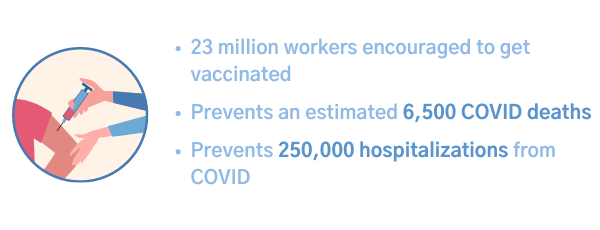The Impact of the OSHA COVID-19 ETS on Employers

The Occupational Safety and Health Administration (OSHA) released its Emergency Temporary Standard (ETS) on COVID-19 Vaccination and Testing on November 4, 2021, with implementation deadlines for large employers (those with 100 or more employees) within 30 days and 60 days of release.
The objective of the ETS, as stated by OSHA, is to minimize the risk of COVID-19 transmission within the workplace by hopefully encouraging approximately 23 million workers to become vaccinated. It is estimated that 6,500 deaths and 250,000 hospitalizations from COVID-19 will be prevented by this measure. For those that remain unvaccinated, regular testing for COVID-19 and use of face coverings should reduce preventable transmissions within the workplace.
Below is a simple “Q&A” summary of the requirements of the Emergency Temporary Standard and how employers can best address the regulations.
Q&A: ETS REQUIRMENTS FOR EMPLOYERS
Q: Why are only “large” employers with 100 or more employees subject to the ETS?
A: OSHA is aware that many small employers may not have the resources to implement the ETS and did not want to create an undue hardship on these employers confronting economic struggles with the pandemic. OSHA is still accepting comments on the ETS and may revise its decision to include smaller employers if determined appropriate. In determining whether a business qualifies as a large employer, employers must count all their direct employees at all company locations, not just per worksite; independent contractors and contingent workforce obtained through other agencies do not count as part of the employer’s direct employee count. If the employer’s employee count remains 100 or more, the employer must comply with OSHA’s ETS.
Q: What if my employees are working remotely?
A: Employees who work remotely and do not report to a location where they contact coworkers or customers are not subject to the provisions of the ETS. Note that remote employees still count towards the requirement of 100 or more employees.
Q: If I have 100 or more employees, what do I have to do?
A: These 6 things:
1. Create, or update, and follow a COVID-19 vaccination policy that requires vaccination or requires unvaccinated employees to submit to weekly COVID-19 testing (if in the office at least once a week) and wear face coverings when indoors or within a vehicle with another person for work purposes. All employees must also be required to give prompt notice to the employer when they are diagnosed with COVID-19 or receive positive test results and the employer must remove them from the workplace, regardless of vaccination status.
2. View and maintain proof of vaccination for each employee and create a summary list of vaccination status for all employees.
3. Give employees up to an additional 4 hours of paid time to obtain vaccination shot(s) and additional paid sick leave to recover from side effects.
4. Advise employees of the ETS and company actions taken to address the regulations; provide them with a copy of the CDC document “Key Things to Know About COVID-19 Vaccines,” as well as information about the laws that protect them from retaliation and discrimination; and inform them of criminal penalties for knowingly supplying false statements or documentation.
5. Report to OSHA work-related COVID-19 fatalities (within 8 hours) and work-related COVID-19 in-patient hospitalizations (within 24 hours).
6. Make available to each employee, and to those with the employee’s written consent, copies of their vaccine documentation and testing results, as well as the number of fully vaccinated employees and total number of employees in the workplace.
Q: Does the employer have to pay for vaccination or COVID-19 testing?
A: No! COVID-19 vaccines are provided free of charge to persons at least five years of age regardless of health coverage. Employers are not required to pay for the weekly testing of unvaccinated employees.
Q: When do these requirements go into effect?
A: Impacted employers must abide by the majority of these requirements within thirty (30) days after the ETS publication, or December 5, 2021. The only requirement with a delayed implementation is testing of those employees that are not fully vaccinated.
Beginning sixty (60) days after the ETS publication, on January 4, 2022, impacted employers must implement weekly COVID-19 testing for unvaccinated employees. (Employees are considered fully vaccinated if they have received one Johnson & Johnson or two Pfizer/Moderna COVID-19 vaccination shots. Booster shots are not currently included in the regulations.)
Q: Wasn’t the ETS implementation halted?
A: On November 6, 2021, the Fifth Circuit Court of Appeals temporarily halted the mandate due to potential legal and constitutional issues. Since that time, other lawsuits challenging the ETS have been filed in all twelve federal circuit courts. Via lottery, it was decided that the U.S. Court of Appeals for the Sixth Circuit will decide the fate of the ETS for the entire nation, including whether the stay of the implementation will be modified, revoked or extended. Both OSHA and the Biden Administration are confident that the ETS will still be allowed to move forward, and employers should make the necessary arrangements to comply.
Q: How can I encourage my employees to get vaccinated?
A. Vaccinated employees are not impacted by the ETS, other than the provisions regarding reporting positive cases and staying out of the office when exposed. For that reason, it is best to encourage employees to get vaccinated. The Department of Labor, Health and Human Services, and Treasury issued guidance on October 4, 2021, allowing health insurance plans to provide a financial incentive to vaccinated employees of up to 30% of the total employee-only medical premium cost as part of a qualified activity-only wellness program. For the wellness program to be qualified, it must:
1. Promote health and disclose all terms of the program to employees.
2. Allow program participants to be eligible for the incentive at least once a year.
3. Include a waiver and equivalent incentive for those employees that cannot get vaccinated due to a medical condition.
Q: How can I make these new regulations more tolerable for unvaccinated employees?
A: To ease the frustration of weekly COVID-19 testing for unvaccinated employees, employers should consider paying for testing and/or providing in-office testing. These pathways to reducing the inconvenience of testing may be a wise employee retention strategy during the Great Resignation.
There are many facets to consider when addressing the impact of COVID-19 and associated deadlines. There may be other local, state, and federal laws that impact your business’ response. The experts at Fahrenheit Advisors stand ready to help you move Straight. Forward. through these complicated business decisions. Reach out to our team at Experts@FahrenheitAdvisors.com.
About the author
 As a Strategic HR Business Partner and Senior HR Consultant, Jennifer Bartlett brings 18+ years’ professional experience in Human Resources, Leadership, Administration, Marketing, Education and Law to Fahrenheit. She is dedicated to providing excellent on-site and remote service, counsel and leadership to clients, executives, managers, employees, candidates, and customers. Her experience ranges from for-profit, public, and non-profit multi-state companies (including California). She is a subject matter expert in all aspects of HR including recruitment, retention, on-boarding, employee relations, employee engagement, performance management, training and development, benefits and payroll administration, compensation, legal compliance, and strategic organizational planning.
As a Strategic HR Business Partner and Senior HR Consultant, Jennifer Bartlett brings 18+ years’ professional experience in Human Resources, Leadership, Administration, Marketing, Education and Law to Fahrenheit. She is dedicated to providing excellent on-site and remote service, counsel and leadership to clients, executives, managers, employees, candidates, and customers. Her experience ranges from for-profit, public, and non-profit multi-state companies (including California). She is a subject matter expert in all aspects of HR including recruitment, retention, on-boarding, employee relations, employee engagement, performance management, training and development, benefits and payroll administration, compensation, legal compliance, and strategic organizational planning.
